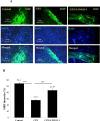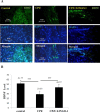Anti-LINGO-1 improved remyelination and neurobehavioral deficit in cuprizone-induced demyelination
- PMID: 34712419
- PMCID: PMC8528247
- DOI: 10.22038/ijbms.2021.53531.12043
Anti-LINGO-1 improved remyelination and neurobehavioral deficit in cuprizone-induced demyelination
Abstract
Objectives: Central nervous system demyelination is the main feature of multiple sclerosis (MS). The most important unmet need in MS is use of treatments that delay the progression of the disease. Leucine-rich repeat and Immunoglobulin-like domain containing NOGO receptor-interacting protein 1(LINGO-1) have been known as inhibitors of oligodendrocyte differentiation and myelination.
Materials and methods: We investigated LINGO-1 antibody effects on remyelination and neurobehavioral deficit using cuprizone-induced demyelination. Animals were randomly divided into three groups (n = 10): (1) Control group; received the regular diet, (2) CPZ group; normal saline was injected intraperitoneally, and (3) Treatment group; LINGO-1 antibody (10 mg/kg) was injected IP once every six days for 3 weeks. We assessed the level of myelin basic protein (MBP), neurofilament heavy chain (NF200), and Brain-derived neuroprotective factor (BDNF) in the corpus callosum (CC) by immunostaining against MBP, NF200, and BDNF.
Results: We found decreased levels of MBP, NF200, and BDNF in demyelinated CC, and anti-LINGO-1 treatment improved demyelinated structures. Furthermore, motor impairment was measured by Open-field (OFT) and Balance beam tests. In the treatment group, motor impairment was significantly improved.
Conclusion: These results provide evidence that LINGO-1 antibody can improve remyelination and neurobehavioral deficit.
Keywords: Brain-derived neurotrophic – factor; Cuprizone; Multiple sclerosis; Myelin basic protein; Nogo receptor 1; Remyelination.
Conflict of interest statement
The authors declare no conflicts of interest.
Figures





Similar articles
-
Nogo-A and LINGO-1: Two Important Targets for Remyelination and Regeneration.Int J Mol Sci. 2023 Feb 24;24(5):4479. doi: 10.3390/ijms24054479. Int J Mol Sci. 2023. PMID: 36901909 Free PMC article. Review.
-
Knockdown of Lingo1b protein promotes myelination and oligodendrocyte differentiation in zebrafish.Exp Neurol. 2014 Jan;251:72-83. doi: 10.1016/j.expneurol.2013.11.012. Epub 2013 Nov 18. Exp Neurol. 2014. PMID: 24262204
-
Thyroid hormone alleviates demyelination induced by cuprizone through its role in remyelination during the remission period.Exp Biol Med (Maywood). 2015 Sep;240(9):1183-96. doi: 10.1177/1535370214565975. Epub 2015 Jan 10. Exp Biol Med (Maywood). 2015. PMID: 25577802 Free PMC article.
-
rHIgM22 enhances remyelination in the brain of the cuprizone mouse model of demyelination.Neurobiol Dis. 2017 Sep;105:142-155. doi: 10.1016/j.nbd.2017.05.015. Epub 2017 May 30. Neurobiol Dis. 2017. PMID: 28576706
-
LINGO-1 and AMIGO3, potential therapeutic targets for neurological and dysmyelinating disorders?Neural Regen Res. 2017 Aug;12(8):1247-1251. doi: 10.4103/1673-5374.213538. Neural Regen Res. 2017. PMID: 28966634 Free PMC article. Review.
Cited by
-
Nogo-A and LINGO-1: Two Important Targets for Remyelination and Regeneration.Int J Mol Sci. 2023 Feb 24;24(5):4479. doi: 10.3390/ijms24054479. Int J Mol Sci. 2023. PMID: 36901909 Free PMC article. Review.
-
Neuroprotective strategies in multiple sclerosis: a status update and emerging paradigms.Expert Rev Neurother. 2025 Jul;25(7):791-817. doi: 10.1080/14737175.2025.2510405. Epub 2025 Jun 3. Expert Rev Neurother. 2025. PMID: 40440559 Free PMC article. Review.
-
Remyelination in Multiple Sclerosis: Findings in the Cuprizone Model.Int J Mol Sci. 2022 Dec 17;23(24):16093. doi: 10.3390/ijms232416093. Int J Mol Sci. 2022. PMID: 36555733 Free PMC article. Review.
-
Anti-inflammatory mechanisms and pharmacological actions of phycocyanobilin in a mouse model of experimental autoimmune encephalomyelitis: A therapeutic promise for multiple sclerosis.Front Immunol. 2022 Nov 3;13:1036200. doi: 10.3389/fimmu.2022.1036200. eCollection 2022. Front Immunol. 2022. PMID: 36405721 Free PMC article.
-
Identification of brain-enriched proteins in CSF as biomarkers of relapsing remitting multiple sclerosis.Clin Proteomics. 2024 Jun 16;21(1):42. doi: 10.1186/s12014-024-09494-5. Clin Proteomics. 2024. PMID: 38880880 Free PMC article.
References
-
- Filippi M, Bar-Or A, Piehl F, Preziosa P, Solari A, Vukusic S. Multiple sclerosis. Nature reviews disease primers . 2018 - PubMed
-
- Nadeem M, Sklover L, A Sloane J. Targeting remyelination treatment for multiple sclerosis. World J Neurol . 2015;5:5–16.
-
- Ava G, Bartolomei I, Costantino A, Berra M, Venturoli S, Salvi F, et al. Long-term influence of combined oral contraceptive use on the clinical course of relapsing-remitting multiple sclerosis. Fertil Steril. 2014;102:116–122. - PubMed
LinkOut - more resources
Full Text Sources
Research Materials
Miscellaneous
